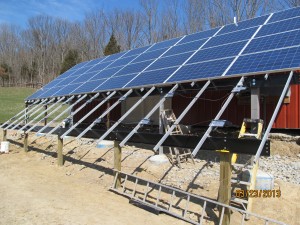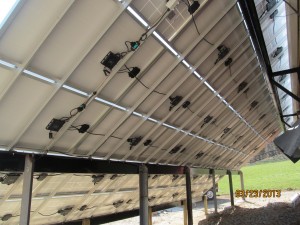I just received this announcement in an email from one of my many electronics industry sources. It describes a new filter, used by the military to protect sensitive electronic gear from EMP or equivalent events. Just thought I’d pass it on! HEMP Filter link
Tag Archives: ohio solar installer
MOTHER EARTH NEWS FAIR 7 SPRINGS PA
Wow, thanks to all who attended my seminar this year! I changed it up a little and made it a presentation of good-to-know FACTS about solar – every aspect of it. Ended up with about 10 minutes of open questions, and I got lucky again – I was able to answer every one with a solid response! Sorry I left my NEW box of business cards at home, but I think the 12 folks who came up to get the 12 I had were the folks most interested in future contact (I hope!). I promised I’d post the PowerPoint presentation, so here it is with the presenters notes included. MEN FAIR 2014 Presentation Nothing that will rock the world, but there might be just that one photo, or factoid that you’ve been looking for! Thanks again for all who were in the PACKED tent (even if you just wanted to get out of the rain!)
Solar Tax Credit extended to 2030!
Here are some highlights from a recent article in SOLAR INDUSTRY MAGAZINE.
If several recently introduced legislative bills give any indication, Congress has heard the call from solar energy advocates to modify the investment tax credit (ITC).
The ITC, which was originally set to expire Dec. 31, 2021, currently pays a credit of 26% for qualifying projects. The tax credit has been extended to 2030!! The credit also covers batteries!
In recent months, both the House and Senate have introduced legislation that not only called for an ITC extension but also stipulates that solar projects should qualify for the tax incentive based on when they start, as opposed to when they are placed into service.
On Feb. 6, Sens. Dean Heller, R-Nev., and Michael Bennett, D-Colo., co-sponsored the Renewable Energy Parity Act of 2014, which would allow developers to qualify for the ITC if projects are under construction before the credit’s expiration date, rather than having to wait until those projects are completed and in service.
In August, Rep. Paul Clark, R-Calif., introduced H.R. 3017, the Renewable Energy Construction and Investment Parity Act of 2013, which also extends the energy tax credit to solar energy, fuel cell, microturbine, combined heat and power systems, small wind energy, and thermal energy properties – the construction of which begins before Jan. 1, 2017.
A whole TOWN goes off grid in Germany!!
Found this story today, and it is really amazing how a little bit of willpower and cooperation allowed this small town in Germany to not only go OFF GRID (total disconnect!) but to also SELL power to neighboring towns at a discounted rate! Read the story here: OFF GRID GERMAN TOWN STORY
HOW MUCH CAN YOU CUT YOUR BILL WITH SOLAR?
It depends on how much roof space (or yard space) you have, and how many panels you install. A good average system size is 24 panels, which in most cases is a PALLET of panels, which gets you the best pricing. My home has 24 panels on it. 20 of them are 230 watt panels and 4 are 240 watts, added at a later date.
My house faces South West, and I have two large hills on the East and West side that shade my roof for an hour and a half in the morning and an hour before sunset. All that considered, here’s what I just got from the electric company on my most recent bill. It tells the story. I have gas heat, so this is just for my electric usage, but that includes AC in the summer months!
Ohio Senate Bill 58 puts solar RPS at risk
If you live in Ohio and own or are considering installing residential or light commercial PV solar, please contact Governor Kasich at his office and tell him you want him to oppose SENATE BILL 58, currently in discussion.
I’ve encouraged everyone I know to do so, and I emailed his office last week. Below is the email response I got:
Dear Joseph:
Thank you for writing with regard to Senate Bill 58. Your letter has been forwarded to me for my review. We appreciate that you took the time to share your views about this important piece of legislation.
Senate Bill 58 is currently being debated during the 130th session of the Ohio General Assembly. Please be assured Governor Kasich will keep your views in mind if Senate Bill 58 is passed by the General Assembly and forwarded to the Governor for his signature. I encourage you to share your concerns with your legislators, as your input will be important as they review this legislation.
Once again, thank you for writing to Governor Kasich. Please do not hesitate to contact the Governor’s office if we may assist you in the future.
Sincerely,
Dave Ward Director of Constituent Affairs
We must all pull together to RAISE the percentage of the RPS (Renewable Portfolio Standard) upon which the Solar SREC values are tied, if we want to preserve the extra value that this represents to the smaller producers of solar energy!! It’s currently pegged at a max of 1/2%, and should be more like 2% of the total 12% renewable energy long term goal.
Thanks!
Joe
Power Point for Mother Earth News Festival in 7 Springs PA
Just thought I’d post this for the convenience of those folks who might attend my seminars this year, and would like to review them at their leisure from home. Even if you don’t attend the fair, there’s some pretty good info in this presentation for anyone considering doing PV Solar as a DIY project. The rest of my blog is filled with lots of detailed photos and text from solar projects of all sizes and equipment types.
Cinci Home Solar presentation at 2013 Mother Earth News Fair in 7 Springs PA
Finish phase 2 expansion at East Fork Stables
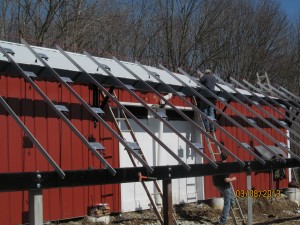
Cinci Home Solar works with EFS to get racking up using 50% on hand materials.
Missed this photo on the first part of this adventure. The owner had materials on hand, and made the posts of Steel L channel, the beams from Steel S-channel, and the barn support brackets from 2 inch steel L material. The owner (George) is a VERY resourceful fellow – some might call him a scrounger, but I call him SMART! I passed along a great vendor deal on the solar panels and he purchased them direct. The BOS (balance of system) materials was purchased through Cinci Home Solar at great pricing, bringing the whole project in at about $3/watt, and this includes the battery bank and backup power inverters in addition to the Enphase micro-inverters behind each panel. The work was spread over 4 full days, with the helper crew varying from 1 to 3 guys and myself. Plenty of manpower to get this rather large project done in a timely fashion. Winter is really variable in Cincinnati, and whenever the weather was predicted to be above 40 and sunny, George called and we got the job done. Fortunately, this job was a quick drive from my home, and it wasn’t a problem. Normally, these 3 or 4 days would have been all condensed into one extended visit! I aim to please, whenever possible…
After we finished the 32 panel array, George saw that some minor grading of the ground near the bottom would allow plenty of room for 2 more rows! A week later he called me and said “Hey Joe, come on out and lets get these 2 rows installed – tomorrow’s weather looks great. So we did! When I ordered the extra components, we also added 8 more rails – one under each of the 8 columns of the upper 4 rows. You can see them mid-panel in the picture to the right. This provided the extra strength and rigidity that the span required for both wind and snow loading. Splicing the extra rails that extend to the newly installed lower beam also provided a counterbalance to the free span above.
The two missing panels at the lower left were intentionally left off because of a stone access road to the hay barn that George didn’t want to move.
This is what the backside looks like after everything is in place. After the rails were set, the Enphase M215 Micro-inverters were mounted. Then the #6 bare copper ground wire was run in series to each inverter. We grounded BOTH ends of the #6 copper, just because we could. Next came the Enphase TRUNK Cable, mounted with stainless steel clips to the rails. Then the panels were added, the micros were plugged in to the trunk cable and the panel leads connected to the micros. One end of the trunk cable is sealed with a weather tight cap, and the other goes to a weatherproof junction box (white) to transition to standard exterior rated 12-3 with ground romex. The romex connects to a breaker box with a 20 amp 2 pole breaker for each string of 16 and 1 string of 14 panels. Then, the entire array is nicely dressed using tie wraps so that all the wiring is suspended between the panels and the bottom of the rails to keep it from whipping in the wind or getting snagged by anything.
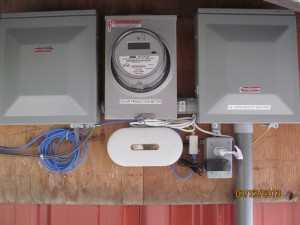
Power Panel beneath the array, mounted to the side of the hay barn.
Here’s the power panel. Public Utility Commission in Ohio says any array over 6Kw must be metered by a UTILITY GRADE meter. Got one on Ebay for $35. Breaker box on left contains the 3 solar breakers. That feeds through the meter to the master breaker box on the right. Master breaker box connects to the utility grid via a buried conduit over to the other barn that had power in it already. Below the utility grade meter is the Enphase ENVOY monitoring unit that ties all this to the internet so George can watch things from his home computer. He can share a link with his friends as well. I’ll post this link soon as I get it from George! The Utility voltage here is rather high – close to the limits for most inverters, at 254Vac. This causes a few of the inverters to occasionally shut down (to protect themselves). I’ll be looking into this further on my next visit to see how we might correct this…
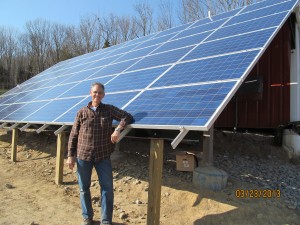
Almost finished DIY solar array accomplished with a little help from Cinci Home Solar!
Here’s the finished array. Still need to trim the excess rail length at the bottoms. If you look close, you might just spot some mis-alignment within the array. George got 2 pallets of panels. Same part number, same vendor, but one pallet was 1/2 inch shorter on the long side (out of spec…). We didn’t catch this till 5 were mounted in the top row. George, being a prudent and thrifty fellow, called the panel supplier and negotiated a compromise that didn’t require a return of the panels. The size only affects the esthetics slightly, and a cost reduction is pending! The Enphase ENVOY normally communicates over the power lines, but there’s a half mile of them back to the house and that’s too far for it to work, so I added an Engenius EOC-1650 at the house as an access point, and atop the array as a client/bridge. It works great – with 100% signal integrity, and also provides WIFI to his customers and visitors! The EOC-1650 is that little white gadget at the top right of the array.
Beginning new Array Construction

This 45 foot hay barn will gain a solar CANOPY extending from the South face just above the rain gutter.
This simple 45 foot hay barn on the East Side of Cincinnati is the location for a 32 panel PV SOLAR CANOPY.
With my help, the owner of this 32 horse boarding stable will erect a massive solar canopy that will cover about 80% of his electricity usage. It will include two Sunny Island battery powered inverters for off-grid backup capability.
This stable is located at the end of a long country road, and it seems he is always first to lose power and last to have it restored. Watering the horses is important to their health, and the backup system will keep trough heaters and well pumps operating when the weather is at its worst in terms of outdoor temperatures.

This 24 inch auger accessory makes drilling the foundation holes an easy task
We were very lucky on this installation, since the property owner had a small bobcat and an augerattachment with a 24 inch bit. The array will measure 13 feet tall by 42 feet wide, which is more surface area than the wing of a regional jet!
This makes it doubly important to anchor the panel mounting structure to mother earth! The property owner is a bit of a scrounger, and he had a nice supply of 1/4 inch thick X 4 inch angle iron for the front row support legs. This will be capped by an S shaped steel beam across the front and rear row. Standard UNIRAC solarmount 160 inch rails will then carry the panels. Brackets attached to the barn vertical wall beams will carry the rear steel rail. Prevailing winds are directly from the south/southwest so the majority of wind loading will be in a downward direction. The steel angle iron and 24 inch concrete columns exceed the requirements needed to achieve the 90 MPH wind rating for the array. AND, the owner saved a bundle since he had the parts on hand!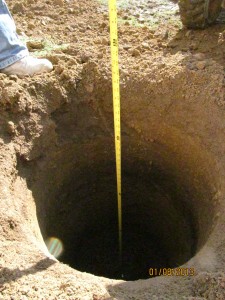
Why bother to take a picture of a hole in the ground? Depending on the jurisdiction and how it works in your area, you may need an inspection BEFORE your pour, so that hole depths can be validated, to assure safe anchoring of the ground mount array. In this case, the property is zoned AGRICULTURE, and inspections are not needed. But just to be safe we documented the depth of every hole. Paperwork can be a pain, but documenting your actions can be worth it’s weight in gold if problems crop up down the line somewhere. And, above all, if you are unsure of where you’re digging, CALL BEFORE YOU DIG. If you need them, GET PERMITS as well. They might be a bit of a hassle, but they are there for a reason – mostly to protect YOU from getting in trouble. Your solar array will be productive and last for MORE than 25 years, so take your time and do things RIGHT the first time! So here is where we left the project yesterday.
So here is where we left the project yesterday.
Those blue forms for the concrete area 50 gallon polyethylene barrels that can be had for about 5 bucks apiece. Cut the ends out and they make forms that will last forever. metal posts and cross beams provide some stability for the steel angle beams that will form the front supports for the array. I’ll add more posts as the project moves along.
It IS January, and weather can always be an issue, but this DIY SOLAR enthusiast plans on seizing every opportunity to get this array completed an online as soon as possible to start reaping the benefits that PV solar can provide!!



